We can all agree that teaching phonics is important.
But there are SO many skills.
Which ones should we teach? And in what order?
Today we’ll look at my recommended order for teaching phonics skills.

Before we get into my recommended order, I want to be clear about a few things.
There is no perfect order for teaching phonics skills.
When choosing your own scope and sequence (mine or someone else’s), do make sure the scope and sequence has the following characteristics (from Wiley Blevins in his wonderful book, A Fresh Look at Phonics).
Qualities of a strong phonics scope and sequence
- It moves from the simplest to most complex skills and builds on previous learning (experts disagree about this order, and that’s okay).
- It allows words to be formed as soon as possible.
- It teaches more common sound-spellings before less common sound-spellings.
- It separates easily confused letters and sounds.
I’ve chosen to break my scope and sequence down into three levels. Technically these levels are kindergarten, first, and second grade, but students need to start where they ARE and, if they are behind, receive a “double dose” of phonics instruction in Tier 2 or 3 so they can reach or exceed grade level benchmarks.
This may mean that you have a group of first graders who are starting in the middle of Level 1. You may also have kindergartners who move so quickly that they’re learning Level 2 skills before the kindergarten year ends.
I recommend assessing phonics knowledge with a quality phonics assessment (you can find that here) and then forming small groups based on phonics knowledge. A caveat: If you choose to teach phonics in small groups, it’s best if you work with other staff so that you don’t have to teach 4-5 groups. Otherwise, students will have to spend most of the reading block in literacy centers. Since they benefit most from explicit instruction from the teacher, this is not ideal. An excellent way to maximize student learning is with the Walk to Read model.

Over the years I have recommended slightly different sequences for teaching consonant and vowel sounds.
However, since I am using the following sequence when writing my series of decodable books (you can find those here), this is what I recommend.
(Again, this isn’t sacred! Adjust accordingly, as long as you follow Wiley Blevins’ recommendations above.)
Consonants, short vowels, and common digraphs / VC and CVC words
s, j, a, t, p, m, d, c, h, r, n, i, b, f, g, k, -ck, o, l, e, sh, th, u, w, ch, wh, x, y, z, qu
Remember that digraphs are two letters that represent one sound. The digraphs in the above list include -ck, sh, th, ch, and wh. “Qu” is technically a blend, but I usually include it with digraphs.
As you are teaching the above letters and sounds, teach your students to read VC (vowel-consonant) words like am and if. Teach them to read CVC (consonant-vowel-consonant) words like cat and pig. Since they are learning digraphs, you will also teach them to read words like rack and chin.
(We have a huge collection of free printables for teaching CVC words, which you can find here.)
Free CVC Word Decodable Books!
Join our email list and get these 3 CVC word decodable books for FREE!
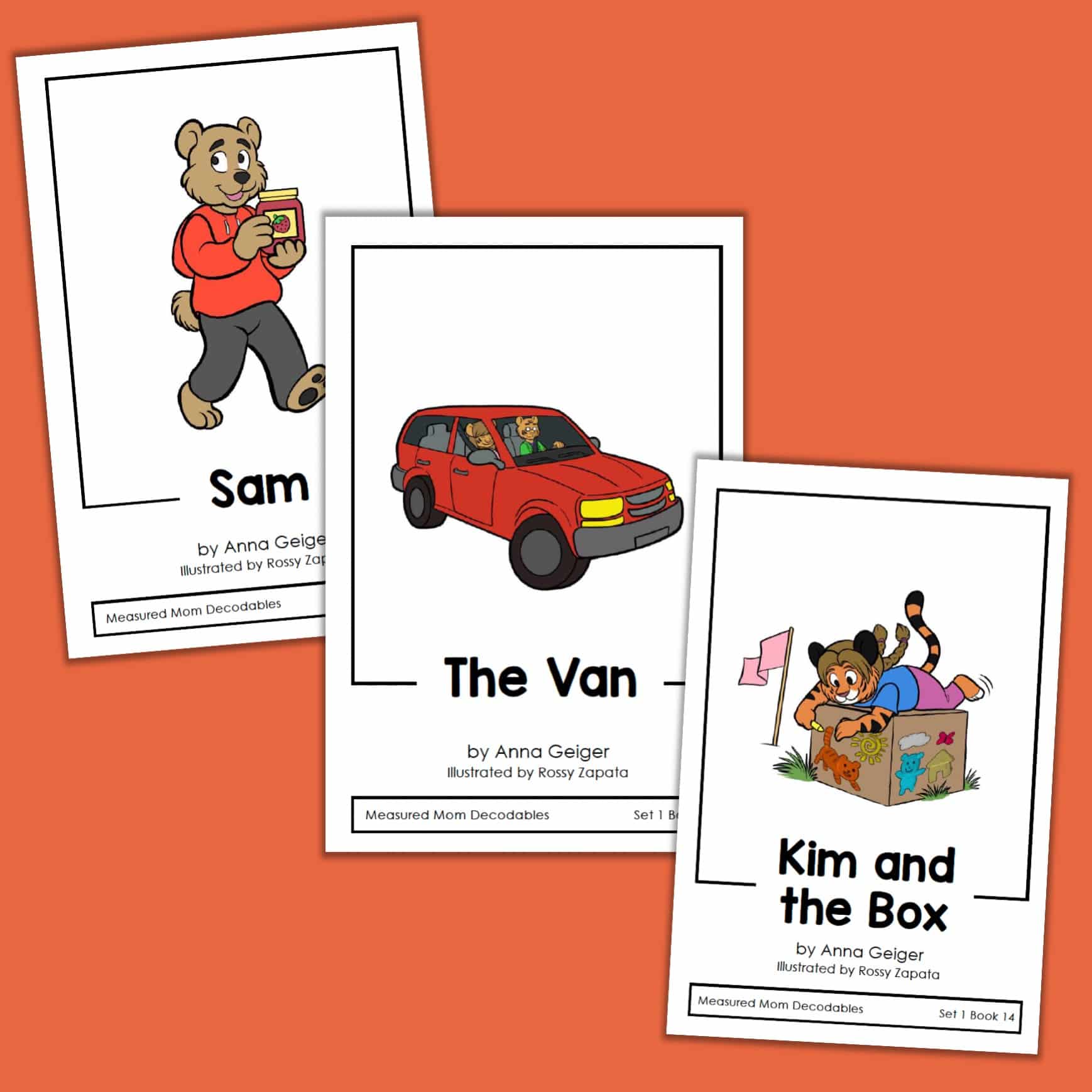
Get our CVC decodable passages
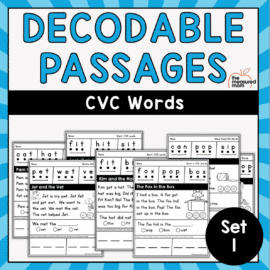
Decodable Passages: CVC Words
$12.00
Use these 23 decodable passages to help new readers develop fluency with CVC words. Each page includes blending practice, a short reading passage, a comprehension question, and spelling practice!
FLOSS rule
The floss rule says that when you spell the /f/, /s/, /l/, or /z/ sound after a short vowel in a single-syllable word, you usually double the final consonant.
“Floss” is a great way to remember this rule, but it doesn’t include the letter z. I love what Emily Gibbons does. She calls it “Zee floss rule” in a silly accent.
Examples: puff, fell, miss, jazz
(Check out my free FLOSS rule game here).
Simple 2-syllable compound words
Teach your students not to be afraid of big words! Now that they can read CVC words, know common digraphs, and understand the FLOSS rule, they can read compound words like catnip and bathtub.
Initial Blends
These days some voices are telling us not to teach blends. One concern is that we don’t want to teach blends as single units; children should simply sound out blends the way they do other letters – sound by sound.
I agree that we need to be careful; blends (sometimes called consonant clusters) are not digraphs. Each letter has its own sound. And it’s absolutely NOT necessary (indeed, it would be a huge waste of time) to teach each blend on its own.
But I don’t have a problem with calling consonant clusters blends, and we can all agree that students need practice reading words with CCVC, CVCC, and CCVCC patterns.
L-blends: bl-, cl-, fl-, gl-, pl-, sl-
R-blends: br-, cr-, dr-, fr-, gr-, pr-, tr-
S-blends: sc-, shr-, sk-, sm-, sn-, sp-, squ-, st-, sw-
Final Blends
-lp, -st, -ct, -pt, -sk, -lk, -lf, -xt, -ft, -nd, -mp, -st, -lt, -nch
(You can check out our free printables for teaching blends on this page.)
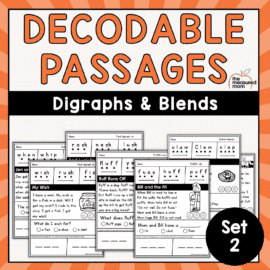
Decodable Passages: Digraphs & Blends
$15.00
Use these 46 decodable passages to help new readers develop fluency with words with digraphs and consonant blends. Each page includes blending practice, a short reading passage, a comprehension question, and spelling practice.
-ng & -nk endings
These are often called “glued” or “welded” sounds. Technically, -ng is a digraph and -nk is a blend (combining the sounds /ng/ and /k/).
It may help to teach these in word families:
-ing, -ang, -ong, -ung, -ank, -ink, -onk, -unk
Long vowel/final blend word families
In my Orton-Gillingham training these were called “kind, old words.” In these word families, the vowel makes a long sound instead of its expected short sound.
-ild, -old, -ind, -olt, -ost
Open & Closed syllable types
Believe it or not, you can teach this concept in kindergarten. Teach your students that when a syllable ends in a vowel, the door is open. The vowel shouts its name through the open door and makes its long sound (no, go, we, be, etc.).
When a syllable ends in a consonant, the vowel makes its short sound (cup, hen, sit, etc.).

Now that students understand open and closed syllables, they’re ready to practice syllable division – if that’s the route you want to go. This is a big thing in the Orton-Gillingham approach, but other approaches skip the division rules and teach a more loose and flexible approach to dividing words into syllables.
Over time I’ve shifted to more a flexible syllable division strategy. But I still believe it’s helpful to teach students to read words with a particular pattern, even if you don’t explicitly name that pattern.
Words with the VC/CV pattern
Words with the VC/CV pattern include napkin, muffin, bandit, and instruct. Now that your students know how to read closed syllable words, they are fully capable of learning to read these words.
Words with the V/CV or VC/V pattern
Words with the V/CV or VC/V pattern are a bit tricky because there is no set rule to tell us whether to divide after the first vowel or after the consonant.
While I used to favor an elaborate Orton-Gillingham-inspired method for dividing words, I now favor a more flexible approach.

V/CV examples: robot, tulip
VC/V examples: denim, visit, credit
Suffix -ed
Teach your students that the suffix -ed is used to show the past tense of verbs. It can represent /t/, /d/, or /id/.
I should note that in my decodable books I include words with the “ed” ending earlier in the sequence. That’s because books get very stilted when you try to avoid the “ed” ending.
In a decodable book I was writing the other day I wrote “Fox hugged his sis.” Otherwise I would have had to write “Fox did hug his sis,” and that just sounds weird. It’s okay to introduce a spelling pattern earlier than it appears in your scope and sequence.
CVCE (Magic e) words
Final silent e has many uses. In Magic e words, it makes the preceding vowel say its long sound.
Sample words: bake, dime, theme, cute, hose
Now that students can read CVCE words, they can read longer words that include this spelling pattern.
Examples: classmate, handmade, timeline
(This site is bursting with CVCE printables! Check them out here.)
Use this activity in Google Slides or Seesaw!
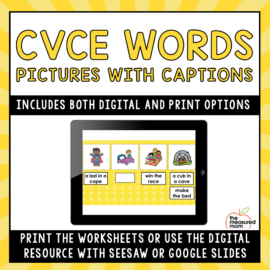
Pictures with Captions – CVCE Words – Google Slides & Seesaw Activity
$2.50
With this no-print resource, students will read each caption and move it under the matching picture. Kids will get a lot of practice, as the activity includes 8 slides … a total of 32 captions to read and match!
Suffix -ing
Teach your students that when adding this ending, they either double the final consonant, drop the e, or make no change to the base word.
Less common digraphs, trigraphs, and silent letters
wr-, kn-, ph-, gh-, gn-, -mb, -tch, -dge
Common vowel teams
Vowel teams are two or more letters that combine to represent a vowel sound. One or more of the letters may actually be a consonant (as in the vowel team igh).
ee, ea, (eat), ai, ay, oa, ow (grow), oe, igh, y (dry), oo (zoo), oo (good)
(So many vowel team goodies on this site – check them out here.)
Don’t forget about multisyllable words!
Sample two-syllable words with one or more vowel teams: hayseed, firewood, raindrop
Spelling with -k, -ke, and -ck
When you hear the /k/ sound at the end of a one syllable word, it is spelled with a k if it is preceded by a vowel that says its name (CVCE), is preceded by a double vowel, or is preceded by a consonant. The sound /k/ is spelled ck when preceded by a single, short vowel.
Sample words: bake, beak, ask, back
R-controlled vowels
An r-controlled vowel is when the letter r influences the preceding vowel’s sound. Traditional phonics programs include the following as r-controlled vowel graphemes:
er, ir, ur, ar, or
Important: when counting phonemes (individual sounds) in words, count an r-controlled vowel as a SINGLE sound. It feels a little weird to do that, but it’s common practice in traditional phonics programs.

(You can find our r-controlled freebies here.)
WORD BUILDING ACTIVITY
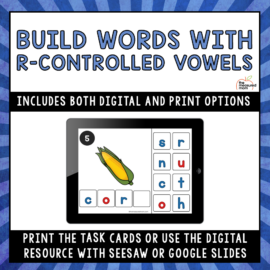
R-Controlled Vowel Word Building – Google Slides & Seesaw Activity
$3.50
Test your students’ knowledge of r-controlled vowels with this no-print word building activity!
R-Controlled vowels syllable type
Be sure to give your students practice with multisyllable words in which one or more syllables includes an r-controlled vowel, such as in barnyard, mutter, and western.

Diphthongs and complex vowels
A diphthong is a vowel sound that glides in the middle. The mouth position shifts during the production of the single vowel phoneme. There is disagreement about which vowel combinations are diphthongs. For our purposes, I include the following.
aw, au, a (as in calm), oi, oy, ou, ow (as in cow)
Now students can also read longer words like cookout, jawbone, and powder.
Note: Many programs include the diphthong syllable type WITH the vowel team syllable type, for a total of six instead of seven syllable types. I’ve done that myself with some printables I’ve made. It’s fine.
Words with the V/V pattern
Sample V/V words: cameo, diet, and fluid.
Consonant-le ending
This is sometimes referred to as the final stable syllable.
-ble, -dle, -fle, -gle, -kle, -ple, -tle, -zle
Now students can read words like bottle, feeble, jingle, and turtle.
Words that end with y as long e
Examples: crispy, giddy, tardy, stubby
soft and hard c and g
When c is followed by e, i, or y, it usually makes its soft /s/ sound. When c is followed by any other letter, it usually makes its hard /k/ sound.
When g is followed by e, i, or y, it usually makes its soft /j/ sound. When g is followed by another letter, it usually makes its hard /g/ sound.
- Soft c words: brace, dance, rancid
- Hard c words: cage, cramp, cup
- Soft g words: age, giant, gerbil
- Hard g words: dog, gift, goat
Lesson common vowel teams
ui, ue, ew, eu, eigh, ei (vein), ei (ceiling), ie (thief), ie (pie), ey, ea (head), ea (break), ou (youth), y (gym)
Words with the schwa sound
The schwa is a muffled vowel sound that is only found in unstressed syllables. In fact, the schwa is actually the most common vowel sound of all. When students are decoding multisyllable words and the word doesn’t sound right, they should adjust the vowel sound in the unaccented syllable. It may just be a schwa!
Remember that the schwa sound is sort of a short u sound (as in tandem) or a short i sound (as in tablet).
Students should already be familiar with schwa, but be sure to address it specifically if you haven’t done so already.
Sample words: abode, bacon, happen, salad, trial
Extra spellings
You have likely already taught these incidentally throughout the years, but just in case these skills need focused attention, you can teach them now.
ch (school), ch (machine), s – /z/
Words with prefixes
un-, re-, in-/im-/ill-, dis-, en-/em-, non-, in-/im-, over-, mis-, sub-, pre-, inter-, fore-, de-, trans-, super-, semi-, anti-, mid-, under-
Words with suffixes
-s/-es, -ed, -ing, -ly, -er/-or, -ion, -ible/-able, -al/-ial, -y, -ness, -ity/-ty, -ment, -ic, -ous, -en, -er, -ive/-ative, -ful,-less,-est
PREFIX & SUFFIX ACTIVITY FOR GOOGLE SLIDES OR SEESAW
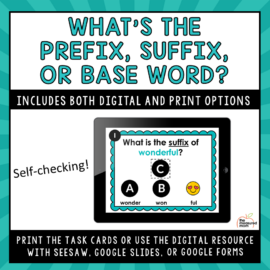
Prefix-Suffix-Base Word – Google Slides & Seesaw Activity
$3.50
Help your students master prefixes, suffixes, and base words with this engaging no-print activity!
Whew! That was a lot! No need to copy it all down … join our email list below and get a FREE scope and sequence chart!
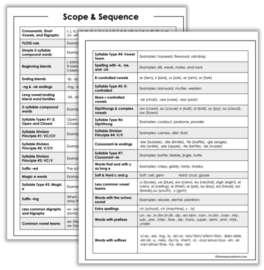
Download your free scope and sequence chart!
Check our the rest of our phonics series!
Part 1Part 2Part 3Part 4Part 5Part 6Part 7Part 8Part 9Part 10


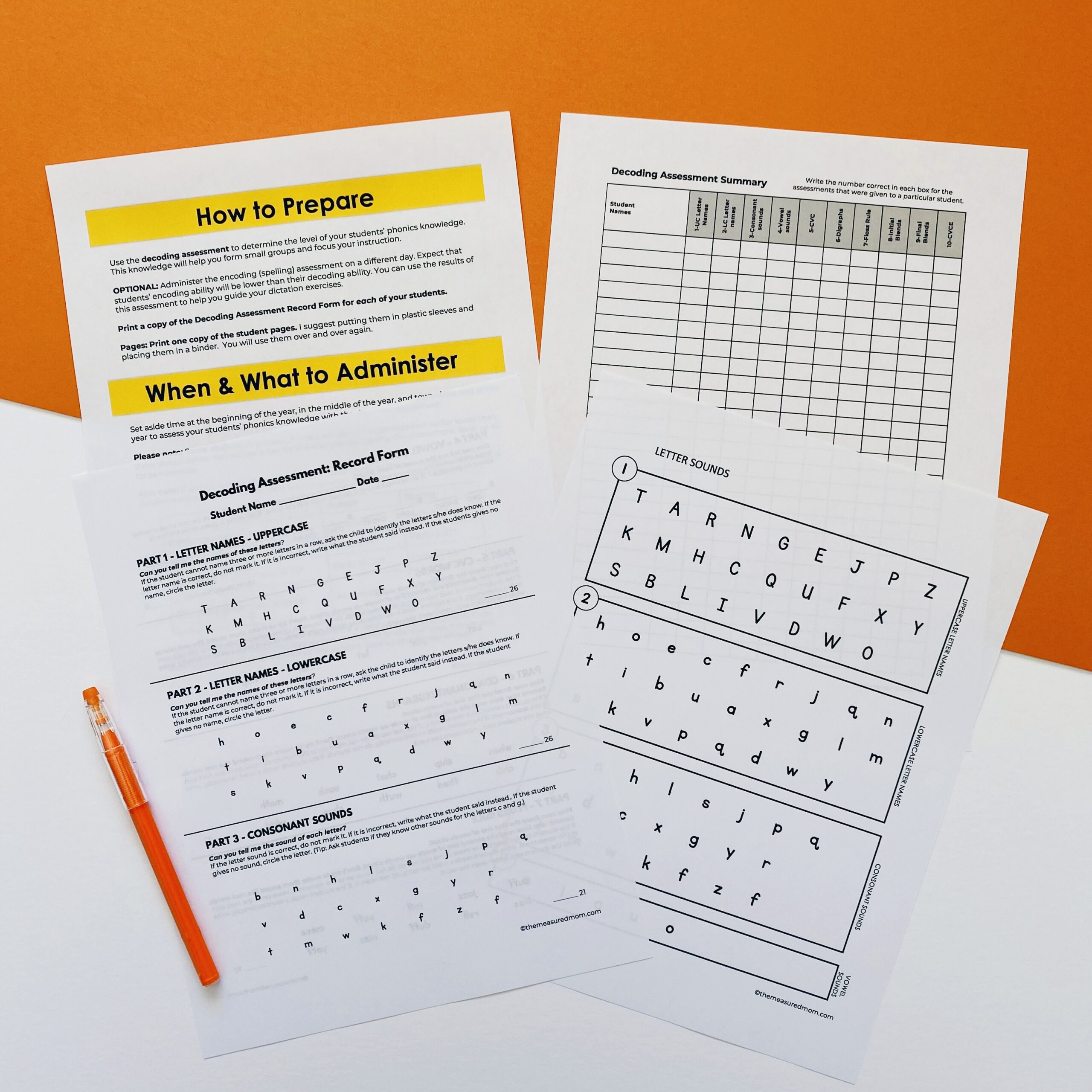
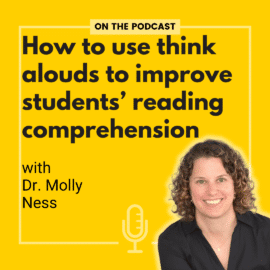
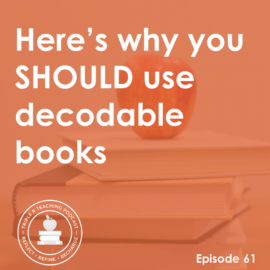
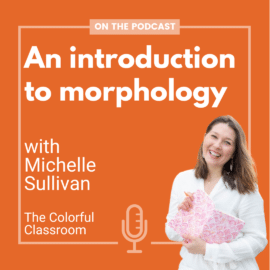
Kris
This is so helpful! Quick question, I’m starting to hear a lot about the effectiveness of teaching syllable division. What are your thoughts on this topic?
Thank you,
Kristin
Anna Geiger
Hi Kristin!
I have learned to do elaborate syllable division through my Orton-Gillingham practicum. Personally, I think it takes far too long and is too complicated. I do think children need a way to divide words into syllables to help them read longer words, but I prefer a flexible strategy like the one shared by Really Great Reading: https://www.reallygreatreading.com/erasing-the-misery-of-reading-and-spelling-multi-syllabic-words
Jill
Since it seems that confusion happens when two spellings for the same sound are presented at the same time, exceptions being when there is a clear reason to choose one (ay, ai), I’m wondering how you break them up? I taught ee and ea (beach) at the same time, then backed off and will return to ea later. So how do you follow this sequence (or any sequence) that presents vowel teams as a group, but also give children a chance to really absorb one before adding in another? I’m thinking of doing one pass on long vowel teams, one per sound maybe, then hitting r-controlled vowels, then coming back to more long vowel sounds. What is common wisdom on this?
Anna Geiger
I agree that this is a tough question, Jill! In the speech to print phonics approach (also called linguistic literacy), multiple spellings are taught at once but not mastered. So they keep reviewing them over time instead of mastering a single one before moving on, as typical programs do. I don’t think research is clear about which is ideal, but I’m concerned that presenting so many at once is going to make learning to spell difficult.
I don’t think there is any research on this – only a lot of opinions!
I like your idea – to do one (or 2-3) spellings per long vowel, and then coming back to them again later. That’s certainly a possibility. In my own sequence we cover the most common spellings and come back later to do less common long vowel teams. I like this approach because you don’t want to put off r-controlled vowels for too long.
There’s a lot of debate about how important it is to get to mastery before moving on, and what mastery even looks like. The most important thing to remember is to do lots of review over time – so that after you teach a pattern, you keep coming back to it.
Kay Curtis
Hi! This is great! Is this sequence based on the frequency of the word patterns showing up in the language?
The one area I have noticed that varies the most in phonics methods is silent e long vowels vs vowel team long vowels. Some systems teach vowel team long vowels first. I haven’t been able to find which long vowel spelling shows up in English more frequently.
Anna Geiger
I have a book coming out that lists all the phonics patterns in order from most to least frequent, but we still have over a year until it’s ready! The tricky thing is that for some long vowels, the vowel-consonant-e pattern is the most common way to spell the sound, but it’s not true for all the long vowels. And yet … you wouldn’t want to split your teaching of the CVCE pattern depending on the vowel – make sense? So I just prefer to teach them all first. But people have varying opinions on this.
Kay Curtis
Just seeing this response! Yes, that makes sense and thank you so much and I really look forward to your book.
Anna Geiger
It’s out now! https://www.amazon.com/Reach-All-Readers-Transform-Instruction/dp/1394205651
Kathy
Thank you for the scope and sequence with comments. Very useful and I read this carefully. I am thinking the sample words for V/V are not all correct. Diet is V/C as is fluid. Some V/V words are: emu, hobo, silo.
V/V SYLLABLE DIVISION PRINCIPLE
This is the least common syllable division occurrence. If you teach syllable division principles, now is a good time to teach this one.
Sample V/V words: cameo, diet, and fluid.
Anna Geiger
Hi Kathy!
The words you listed as V/V would actually be V/CV. Here’s a blog post from another teacher that lays it out! https://sarahsnippets.com/syllable-division-rules/
Laura Koning
This is a great tool. Is there a cliff note version of the order of phonics instruction, a reference document?
Thanks. I’ve bookmarked this article.
Laura
Heather Groth, Customer Support
Yes, there is, Laura! You can download the two-page scope and sequence chart from this same page. Just scroll to the bottom of the article to where you a box that says, “Download your free scope and sequence chart.” From there you can print out the chart or save it to your computer for easy reference!
Yugi
When I click on the link to download the scope and sequence, it takes me to another website. Can you check on that?
Heather Groth, Customer Support
Hi Yugi! When you click on the link, a pop-up should appear asking for your name and email address. Then the Phonics Scope and Sequence is sent directly to the email that you provide. The link is working for me now, can you try it one more time and see if it works for you? Thank you!
Erin DOcherty
Love how you have put them in three levels. Can explain better with what level a child is currently in.
Erin D.
Anna Geiger
I’m glad this was helpful, Erin! I organized them this way because that’s how I plan to release phonics resources; in general they are meant to line up with grade levels, but I always believe in going back or forward depending on what a child’s needs are.
Jill Leech
Thank you so much for sharing this resource! It will really helpo me in my job helping students who need reading intervention!
Anna Geiger
I’m so glad to hear that, Jill!
Melissa Griffin
Thank you for this scope and sequence!!
Anna Geiger
You’re very welcome, Melissa! 🙂
Leah
So helpful, thank you!
Heather Groth, Customer Support
You’re welcome, Leah!